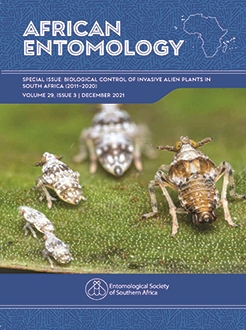Cestrum (Solanaceae) species have become invasive in conservation and agricultural areas in South Africa, resulting in the initiation of a biological control (biocontrol) programme against these species in 2007. Of the four Cestrum species recorded in South Africa, Cestrum laevigatum Schltdl. and C. parqui L'Herit., which are both commonly referred to as inkberries, have become invasive while C. aurantiacum Lindl. and C. elegans (Brongn.) Schltdl. are still isolated at a few sites in the country. The biocontrol programme against Cestrum species (commonly called cestrum) was initially focussed on pathogens associated with these plants. Although the fungus Uromyces cestri Bertero ex Mont. (Pucciniales: Pucciniaceae) was found to be a promising agent for cestrum, the pathogen project was shelved due to lack of capacity. Field surveys conducted in Argentina from 2012 to 2020 revealed a total of eight phytophagous insects that could be candidate agents. Among these is a leaf-feeding flea beetle Epitrix sp. (Coleoptera: Chrysomelidae) that has been tested for host specificity. Out of 47 plant species tested to date, Epitrix sp. has only fed and developed on three Cestrum species, suggesting that it is suitable for release against cestrum in South Africa. Permission to release Epitrix sp. will be sought once it has been identified to the species level or it has been described as a new species. Two chrysomelid beetle species, a root-feeding flea beetle (Diphaulaca sp.) and an unidentified leaf-feeding flea beetle, were also collected on C. parqui, but attempts to rear the former were unsuccessful. Three other leaf-miners collected from C. parqui include: Acrocercops leucographa Clark (Lepidoptera: Gracillariidae), an unidentified moth (Lepidoptera: Argyresthiidae) and Liriomyza sp. nr. schlingerii (Diptera: Agromyzidae). A glass-winged butterfly (Lepidoptera: Nymphalidae) was the only herbivore that may be of biocontrol value on C. laevigatum. Whilst it is essential to extend the surveys to other regions of the native range, it is also important to prioritize the most promising potential biocontrol agents for further testing in South Africa. Given the suite of potential biocontrol agents in the native range, there are good prospects for the biocontrol of cestrum species in South Africa.
How to translate text using browser tools
31 December 2021
Progress and Prospects for Biological Control of Cestrum Species (Solanaceae) in South Africa
D.O. Simelane,
K.V. Mawela,
M. Teresa Defagó,
A. Salvo
ACCESS THE FULL ARTICLE
It is not available for individual sale.
This article is only available to subscribers.
It is not available for individual sale.
It is not available for individual sale.

African Entomology
Vol. 29 • No. 3
December 2021
Vol. 29 • No. 3
December 2021
biocontrol
Cestrum species
Epitrix sp.
host-specificity tests
natural enemies





